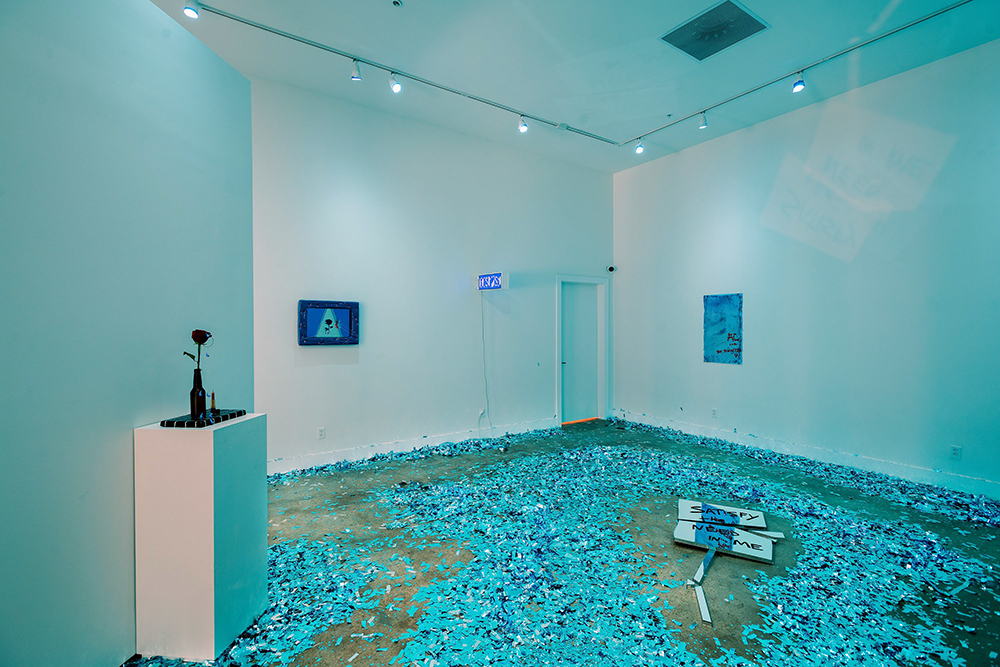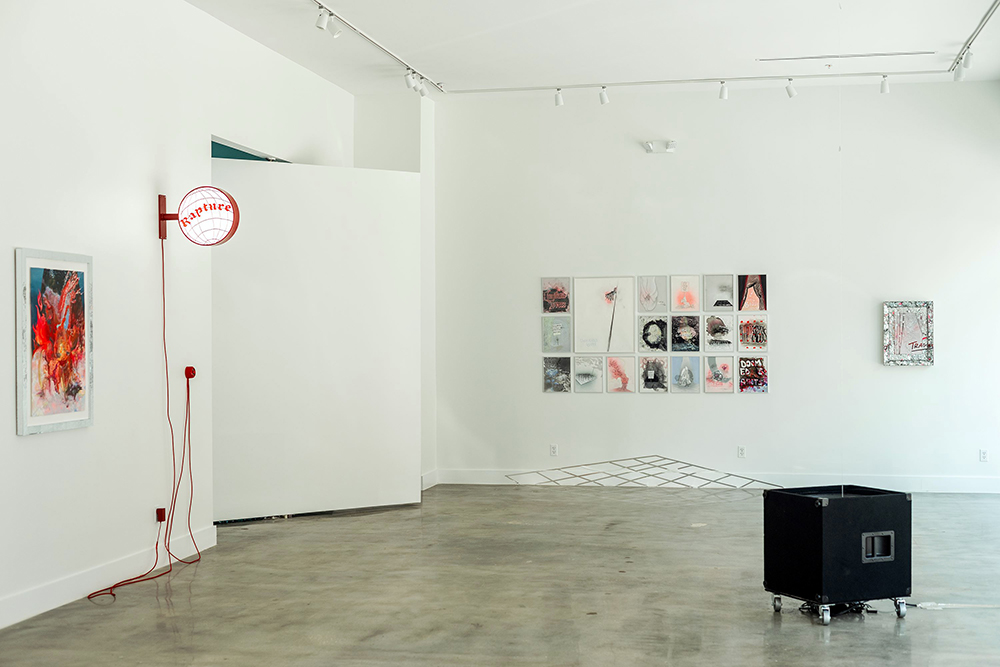Joel Parsons’ show at Sheet Cake Gallery wasn’t supposed to be this relevant. When he started creating his pieces for “Club Rapture and the Ecstasy Afters,” he wanted to recall the memories of queer protests and movements, of queer dance spaces, and the connections between them. From the beginning, he knew he’d incorporate protest signs to talk about the intersection of politics and pleasure, but he thought the signs would look “quaint,” maybe “out of step.” At least, he hoped.
“I didn’t know that it would also be showing up in the streets,” he says. “I thought it would kind of feel historical. … I really didn’t think that this would be the current political situation.”

As his process deepened and the new presidential administration took over, Parsons, absorbed in the history through which he planned to view queer pleasure and politics — from Stonewall in 1969 to the Pulse nightclub shooting in 2016 to Memphis’ own queer dance scene — saw, unflinchingly, past and present colliding in a mirroring timeline. He saw how pleasure and joy always existed even in the most dire of circumstances. “Part of what the show became for me as I was working on it, and what I hope people get out of it, is that even though the world is sort of on fire, it’s still okay to find pleasure and to love other people, and to have all of the goodness in the world, even as so much of the world is hurting and there’s so much that needs to change.”
Parsons thought back to queer activists in the ’90s. “They would say, ‘We would go to a funeral in the morning to bury our friends who had died of AIDS. We’d go to a protest in the afternoon, and then we’d go out dancing at night, and that was a typical Saturday.’”
With that in mind, the artist created a fictitious “Club Rapture” in the gallery space for such a scene — or, really, any club experience — to take place. Tucked away in the corner are those protest signs the club-goers have put aside to party — these with lyrics from the unofficial AIDS anthem “Don’t Leave Me This Way” by Thelma Houston. With messages like “Set Me Free” and “I Can’t Exist,” Parsons says, “The idea is that the signs could be directed at the country or a lover … conflating the political and the intimate.”
For another moment of conflating the intimate with the political, Parsons created State of Union, a clouded restroom mirror with “for a good time call” scrawled on with bright red lipstick or marker. A phone number when dialled leads to a voice message that could be left for the state or a lover: “I don’t think we want the same things. … I revolt. It’s still love.” Meanwhile, “Don’t Leave Me This Way” plays in the background as if the voice on the phone is lost at Club Rapture, the music blaring.
The name Club Rapture, Parson says, is a nod to the “rapturous experience of being with people on the dance floor and being in community and finding pleasure.” It’s also tied to the religious symbolism and language he employs throughout the show. “I was thinking about those clubs as a kind of sacred space,” he says. “I’m thinking about how these clubs are almost like cathedrals. It’s a place where people find communion.”
Some of his works are direct references to religious works, like Rubens’ Descent from the Cross and da Vinci’s Martyrdom of Saint Sebastian. “I started to see these sort of visual rhymes between these religious images that were often about these moments of intensity, like grief or death or rebirth, and then seeing those shapes or forms or ideas duplicated in these dance floor photos, so it made a lot of sense to kind of bring those in an explicit way.”
Stained glass, too, with all its religious connotations, appears in the show, making it Parsons’ first show in Memphis to contain the form. “I just started combining [enamel] with stained glass [about a year ago],” Parsons says. “I’m slowly working my way through different glass techniques and seeing what I can do. And I always like to do it wrong, like I do it all incorrectly. I teach myself. I watch all these videos and people say, ‘Oh, you can’t do this.’ And I’m like, ‘Well, let me try it.’ There’s all kinds of stuff in the show that shouldn’t really work, that I just didn’t know better than to not try it, which is also, to me, a way of being queer in the process. …
“And I like how it’s so beautiful, but it’s also really fragile. It’s super archival; it will last pretty much forever. But then one wrong move, and it could shatter on the floor. I like all those tensions.”
These tensions, Parsons adds, also carry in a motif of roses — a symbol of love and affection, but also of memorials. In Parsons’ work, the rose often takes the place of the figure, and in this show, a line of glass roses wait under a “no cover” banner to get into Club Rapture. “It’s also like a memorial that reminds you of images of Pulse nightclub after the shooting. And so I’m trying to combine those images of love and affection and exuberance with grief and mourning, trying to layer those things together as much as I can because that’s my experience with the world right now.”
As these tensions and more are revealed, what’s left is what Parsons calls the “Ecstasy Afters” — “the idea of what happens when you leave the club, that kind of cold blue light of morning coming in as you stumble out [and] head back out into the world.”
“We all feel, on some level, tired and defeated and scared, but then, what we have is each other, and we have a moment where we can dance and look each other in the eyes and experience joy in a communal way. Maybe that’ll get us through, and maybe that’s worth fighting for. But yeah, there’s a lot of ambivalence.”
“Club Rapture and the Ecstasy Afters” is on display at Sheet Cake Gallery through May 17th.
